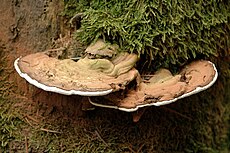Ganoderma
Ganoderma is a genus of polypore mushrooms that grow on wood, and include about 80 species, many from tropical regions. Because of their extensive use in traditional Asian medicines, and their potential in bioremediation, they are a very important genus economically. Ganoderma can be differentiated from other polypores because they have a double-walled basidiospore. They are popularly referred to as shelf mushrooms or bracket fungi.
The name Ganoderma is derived from the Greek ganos/γανος "brightness, sheen", hence "shining" and derma/δερμα "skin". The genus Ganoderma was erected as a genus in 1881 by Karsten and included only one species, G. lucidum (Curtis) Karst . Previously, this taxon was characterized as Boletus lucidus Curtis (1781) and then Polyporus lucidus (Curtis) Fr. (1821) (Karsten 1881). The species P. lucidus was characterized by having a laccate pileus and stipe, and this is a character that Murrill suspects was the reason for Karsten’s division because only one species was included, G. lucidum . Patouillard revised Karsten’s genus Ganoderma to include all species with pigmented spores, adhering tubes and laccate crusted pilei, which resulted with a total of 48 species classified under the genus Ganoderma in his 1889 monograph. Until Murrill investigated Ganoderma in North America in 1902, previous work had focused solely on European species including, for example, G. lucidum, G. resinaceum Boud. (1890) and G. valesiacum Boud. (1895).
Ganoderma are characterized by basidiocarps that are large, perennial, woody brackets also called "conks". They are lignicolous and leathery either with or without a stem. The fruit bodies typically grow in a fan-like or hoof-like form on the trunks of living or dead trees. They have double-walled, truncate spores with yellow to brown ornamented inner layers.
...
Wikipedia

